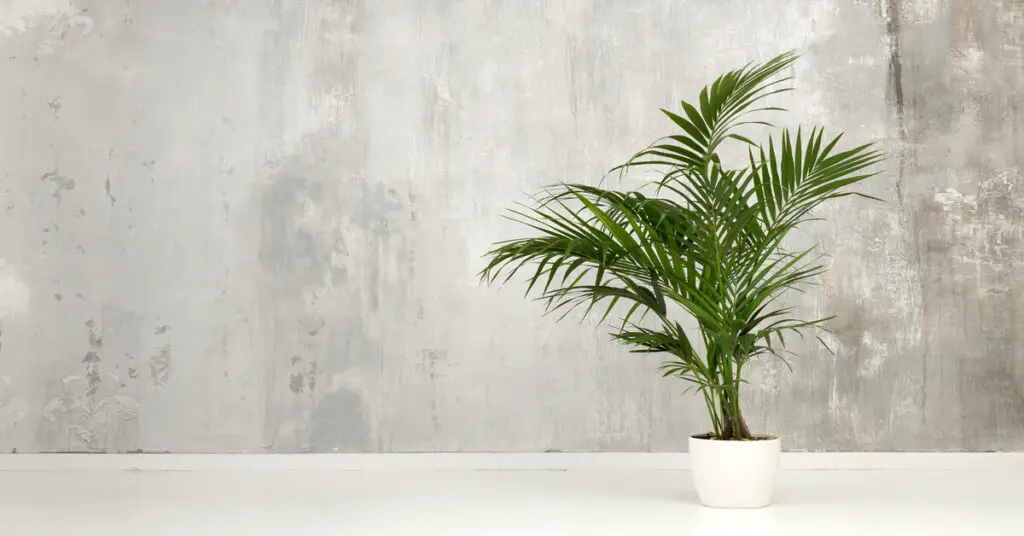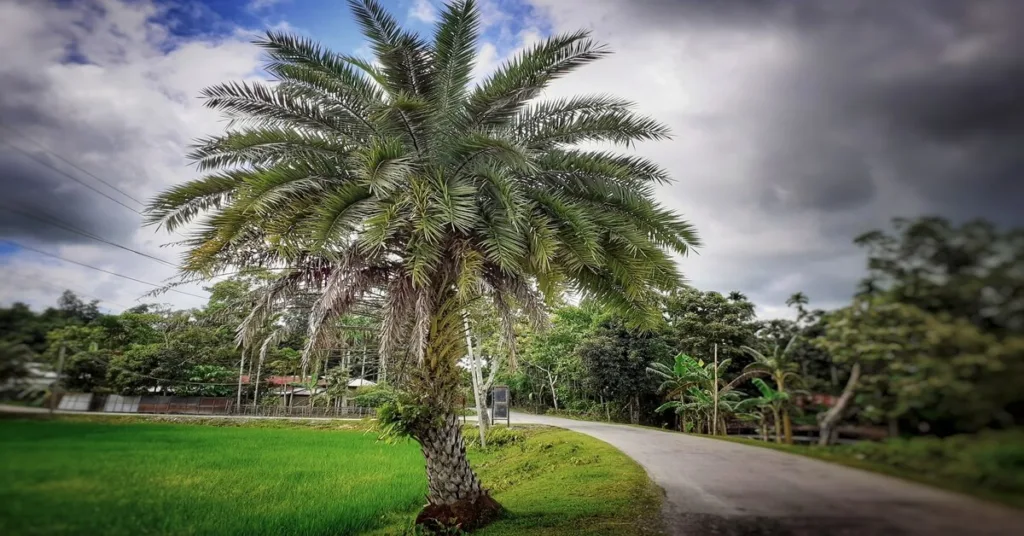Welcome to Kentia Palms, the elegant stars of indoor gardening! These lush, easy-to-care-for palms bring a touch of tropical serenity to any space. Whether you’re a seasoned green thumb or a budding plant enthusiast, our guide will unlock the secrets to nurturing your Kentia Palm to its full, vibrant potential. Let’s embark on this green journey together, transforming your home into a tranquil, leafy paradise with these graceful, air-purifying wonders.
Understanding Your Kentia Palm

Origin and Characteristics
Hailing from the serene shores of Lord Howe Island, the Kentia Palm (Howea forsteriana) symbolizes exotic elegance. These palms reach majestic heights in the wild, flaunting their slender trunks and arching fronds. As houseplants, they offer a more compact form yet retain their graceful poise. This resilience and adaptability make them a favorite among indoor plant enthusiasts.
Popular Varieties
While the classic Kentia Palm is popular, several varieties bring unique flair. Variants like the ‘Thatch Palm’ impress with denser fronds, while others boast subtle differences in leaf shape and growth habit. Understanding these varieties enables gardeners to select a Kentia Palm that suits their aesthetic preferences and space constraints.
Optimal Soil Conditions
Soil Composition
The foundation of a thriving Kentia Palm lies in its soil. These palms prefer a well-draining yet nutrient-rich mix, balancing moisture retention and aeration. A blend of perlite, peat moss, and organic compost creates an ideal environment, fostering robust root growth and overall plant health. Regularly amending the soil with organic matter boosts fertility and ensures the palm has access to essential nutrients.
Repotting Essentials
Kentia Palms grow moderately, necessitating periodic repotting to accommodate their expanding root system. Typically, a biennial repotting routine suffices. Selecting a pot with adequate drainage holes is crucial to prevent waterlogging, a common pitfall in palm care. When repotting, gently encase the root ball in the new soil mix, ensuring stability and room for growth. This process revitalizes the plant and is an opportune moment to inspect and treat any potential root diseases.
Watering Your Kentia Palm Correctly
Watering Frequency and Quantity
Mastering the watering schedule is critical to Kentia Palm Care. These palms favor a ‘less is more’ approach, thriving when the top inch of soil dries out between waterings. Overwatering is a common misstep, leading to root rot. In warmer months, they may require more frequent watering, while in cooler seasons, less is needed. Monitoring soil moisture is crucial – when in doubt, it’s better to under-water than over-water.
Common Watering Mistakes
Avoiding overwatering is paramount. Using lukewarm water minimizes shock to the roots, enhancing absorption. Additionally, ensuring excess water drains freely and removing standing water from saucers prevents root rot. By understanding these nuances, you can ensure your Kentia Palm receives just the right amount of hydration to flourish.
Lighting Requirements
Ideal Light Conditions
Kentia Palms are renowned for their flexibility in lighting conditions, a trait that endears them to indoor gardeners. They prefer bright, indirect light to mimic their natural, dappled sunlight habitat. Direct sunlight should be avoided, as it can scorch their delicate fronds. A north or east-facing window is often ideal, providing the soft light these palms crave.
Adjusting to Home Environments
Not all indoor spaces can offer ideal light conditions, but Kentia Palms are forgiving. In low-light areas, their growth may slow, yet they remain healthy. Consider using grow lights that simulate natural sunlight for spaces lacking natural light, ensuring your palm continues to thrive.
Maintaining Humidity and Temperature
Creating a Tropical Environment
Kentia Palms, originating from a tropical climate, thrive in humid conditions. Aim to maintain indoor humidity levels that mimic their natural habitat. Regular misting helps maintain adequate moisture, promoting lush foliage. However, ensure good air circulation to prevent fungal issues. The ideal temperature range for Kentia Palms is between 65-75°F (18-24°C) during the day, with a slight drop at night, ensuring they are not exposed to temperatures below 55°F (13°C).
Seasonal Adjustments
Adapting to seasonal changes is crucial for Kentia Palm Care. Indoor heating can reduce humidity in winter, so using a humidifier or placing a water tray near the plant can help. Conversely, ensure the palm isn’t near air conditioning vents in summer, as cold drafts can stress the plant. Adjusting to these environmental shifts is key to keeping your Kentia Palm healthy year-round.
Nutrition and Fertilization
Fertilizing for Growth
Fertilizing plays a pivotal role in the lush growth of Kentia Palms. During spring and summer growing seasons, a balanced, slow-release fertilizer is ideal. It provides a steady supply of nutrients, vital for maintaining vibrant foliage. Diluting the fertilizer as per package instructions is important to avoid over-fertilization, which can lead to nutrient burn.
Signs of Nutritional Deficiency
Observing your Kentia Palm’s health can alert you to potential nutritional deficiencies. Symptoms like yellowing leaves or stunted growth indicate a need for a healthy boost. Adjusting the fertilization regimen in response to these signs helps maintain the palm’s vitality.
Disease and Pest Management
Common Pests
While relatively hardy, Kentia Palms can occasionally fall prey to pests like spider mites and mealybugs. Regular inspection is key to early detection and control. Treatments such as neem oil or insecticidal soap can be effective if pests are spotted. Keeping the plant clean and dust-free also plays a role in preventing infestations.
Disease Prevention
Fungal diseases can arise in poor ventilation or overwatering conditions. Ensuring a well-draining soil mix and adequate air circulation is crucial. Promptly removing any affected leaves and adjusting care practices helps prevent the spread of diseases.
Grooming and Pruning
Pruning Techniques
Pruning is essential for maintaining the health and aesthetics of Kentia Palms. Remove brown or yellowing leaves at the base to encourage new growth and prevent disease spread. Use clean, sharp pruning shears for clean cuts. Pruning should be done judiciously, as excessive cutting can harm the plant.
Maintaining Aesthetic Appeal
Regular grooming, like dusting the leaves and checking for pests, keeps the Kentia Palm looking its best. This enhances the plant’s appearance and promotes better light absorption and overall health.
Propagation Methods
Seed Germination
Propagating Kentia Palms from seeds is a patient gardener’s game. The germination process can take up to six months or longer. The seeds require a warm, humid environment, ideally between 80-85°F (27-29°C), to encourage germination. Providing consistent moisture and warmth is key to successful propagation.
Challenges in Propagation
Due to their slow growth and specific germination requirements, propagating Kentia Palms can be challenging. Maintaining optimal conditions throughout the process and being prepared for a lengthy wait before seedlings emerge is essential.
Safe Coexistence: Pets, Children, and Kentia Palms
Non-Toxicity and Safety
One of the appealing aspects of Kentia Palms is their non-toxic nature, making them a safe choice for households with pets and children. However, placing these plants out of reach is always prudent to avoid any accidental ingestion or damage, ensuring a harmonious and safe environment for all.
Best Practices for Placement
In addition to safety considerations, the placement of Kentia Palms should also consider aesthetic and practical aspects. Choose locations that provide the right light and temperature conditions and complement the overall decor, creating a peaceful and attractive indoor garden space.
Conclusion
Caring for a Kentia Palm is a rewarding journey that enhances any indoor space with a touch of tropical elegance. You can ensure your palm thrives by understanding and implementing the right soil, watering, lighting, and temperature conditions, along with proper fertilization, pruning, and pest management. Remember, patience and attention to detail are key. Embrace the process, and watch as your Kentia Palm becomes a stunning testament to the joys of indoor gardening.


